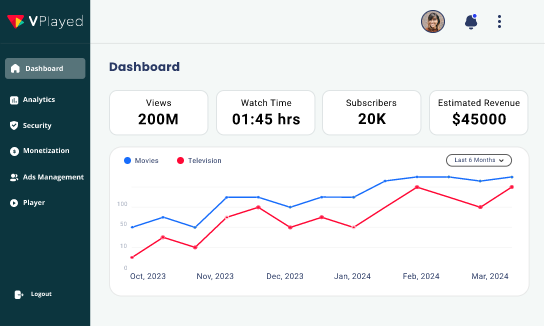Stream & Earn Revenue From Your Video Content With 10+ monetization Models & 1000+ Features.
Book a Free DemoWhat is Video Monetization: How To Monetize Your Online Content in 2026?
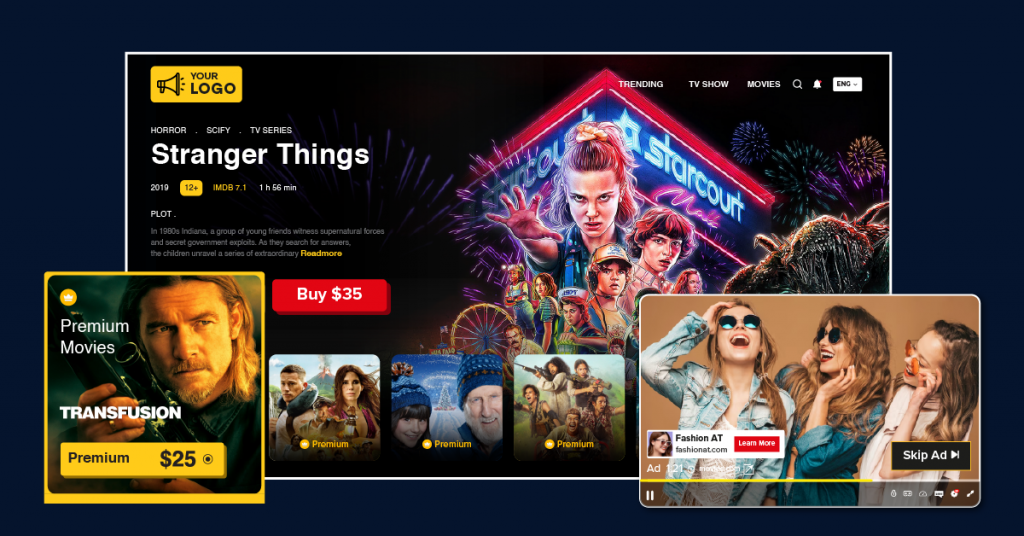
Summarize this article via
If you’re wondering, ‘What is video monetization?’ then this blog post is for you. 82% — that’s how much video content is occupying the internet traffic in 2026. So, how do you monetize your video assets in this sea of videos?
You’re not alone in feeling overwhelmed by the options. From subscription to advertising model, and pay-per-view to sponsorships, the online video monetization landscape can seem complex and confusing. But here’s the catch: successful creators who make consistent revenue understand the fundamentals of video monetization strategies.
In this blog, we’ll break down essential information on multiple video monetization models available to you, and key challenges that you might face while trying to monetize video content.
- Fully Customizable
- Lifetime Ownership
- On-Premise/On-Cloud
- 100% White-label
- Zero Revenue Share
- Hire Developers
Table of Contents
What is Video Monetization?
Video monetization is a process of generating revenue, involving multiple video content monetization models like subscriptions, advertisements, brand partnerships, or donations. Content creators leverage video monetization models to make consistent revenue with a monetization strategy.
The audience’s interaction with their video content generates income for them. With the right monetization strategy, you can monetize just about every video content, both live video and video-on-demand.
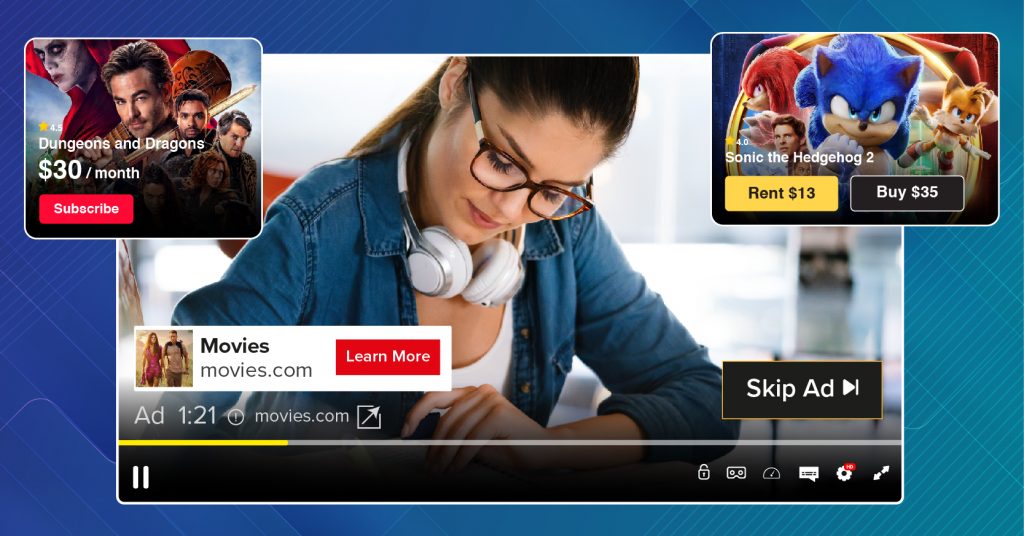
Video monetization often gets associated with subscriptions, advertisements, and pay-per-view; however, it encompasses a wide range of models, which we will explore later in this blog. Content creators and broadcasters often miss the underlying benefit of video monetization: that is to reach a wider audience than they imagine!
Top Video Monetization Models That Amplify Your Revenue
If you do not know the best way to monetize video content, this section of the blog is right for you. Here are the top ways to monetize your videos content in 2026:
1. AVOD: Advertising Video On Demand
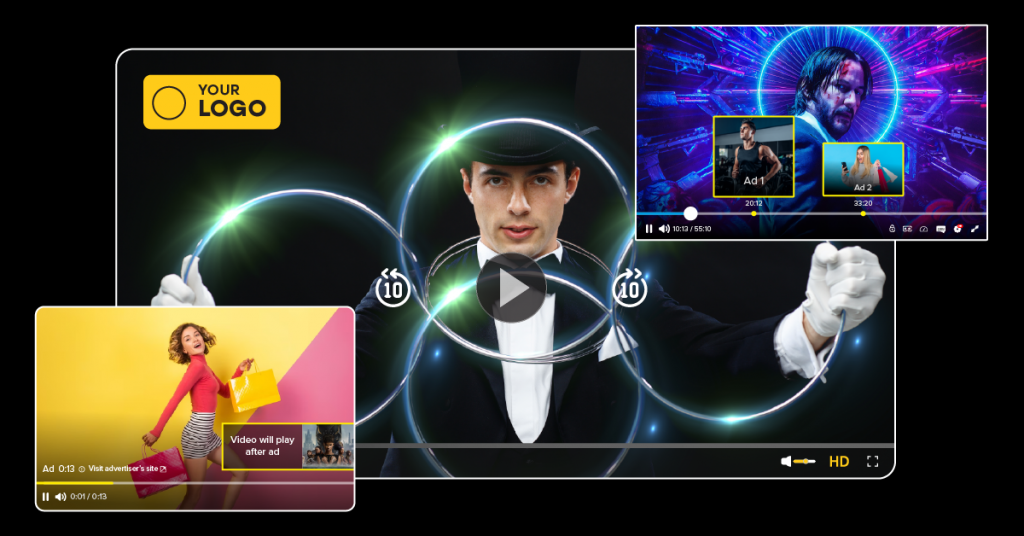
Advertising video-on-demand (AVOD) is a popular video monetization strategy where content owners partner with online video monetization platforms or specialized ad networks to display ads within their video content.
This strategy is beneficial for broadcasters with a vast video library and a substantial viewer base. Once the ads are set up, they passively earn a share of the revenue generated from viewer interactions with the ads, be it clicks or impressions.
YouTube is one on the best AVOD platforms embodying the advertising-based revenue strategy, with advertising revenue increasing by 13% year over year, according to Alphabet, Google’s parent company.
Some best practices of ad-based video monetization model is targeted advertising, strategic ad placement, and prioritizing quality over quantity.
2. SVOD: Subscription Video On Demand
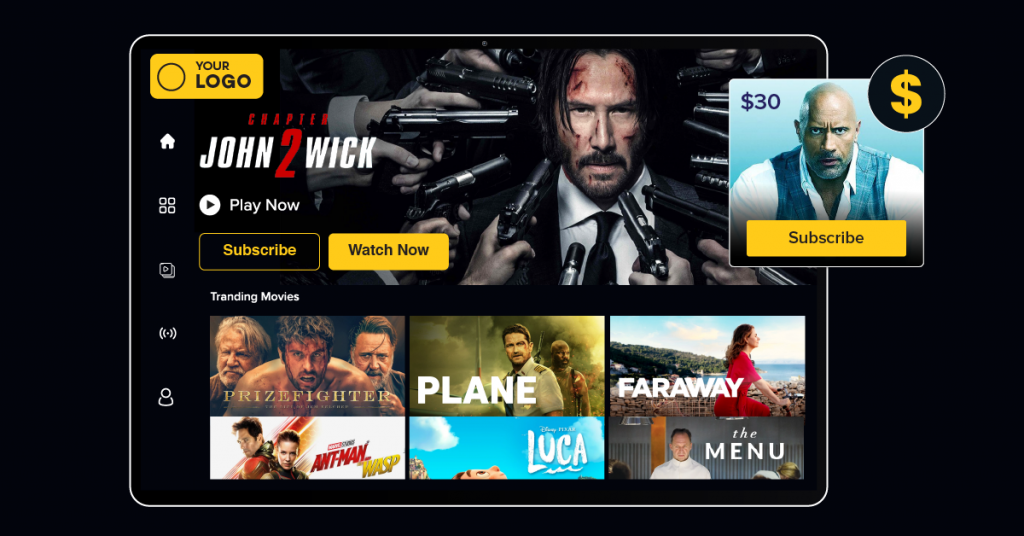
Subscription video-on-demand (SVOD) includes tiered subscription plans for which viewers will pay a recurring subscription fee, either monthly, quarterly, or annually. Content owners curate subscription plans based on the content type, access levels, and target audience segments.
This model provides predictable recurring revenue, making it attractive for content owners with premium or exclusive material. Unlike AVOD, SVOD Platforms typically offers ad-free viewing experiences, positioning the subscription fee as the primary revenue source.
Netflix is a popular platform embodying the subscription-based video monetization strategy, which claims 282.7 million paid subscribers worldwide. The stat suggests that the platform’s subscriptions thrive continuously due to its original content library.
Some best practices of subscription-based online video monetization are offering flexibility in subscription plans, enhancing the value proposition, and fostering long-term community building.
3. TVOD: Transactional Video On Demand
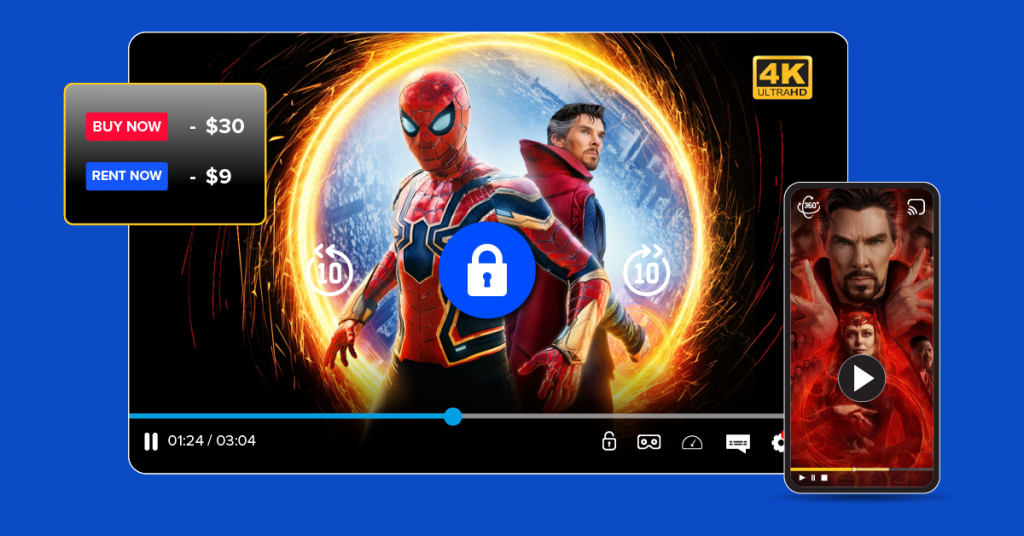
Transactional video-on-demand (TVOD) offers limited-time access to specific content for a one-time fee. Content owners can preserve the exclusivity factor while leveraging this video monetization strategy for their video content.
This model provides guaranteed revenue for content owners while taking long-term subscription commitments out of the equation. This model is suitable for content creators hosting virtual events (like webinars, conferences) and broadcasters owning access to exclusive live events (soccer matches, NBA matches).
Ultimate Fighting Championship’s (UFC) one-time exclusive pass for every match is a classic example of transactional video-on-demand. The fans ultimately pay and procure access for the match they wish to watch, which is valid for 24 hours.
Some best practices of the TVOD model are flexible pricing, promotion, and post-event engagement.
4. Hybrid Model

Hybrid Model is a mix of subscriptions, advertisements, and transactional approach. This flexible model leaves no audience segment untouched, enabling content owners to maximize their video content monetization oppertunities.
The hybrid model leverages advertising (AVOD) to build recurring audiences, subscriptions (SVOD) to build recurring revenue, and pay-per-view (TVOD) for producing exclusive content.
Popular platforms leverage this hybrid model: Hulu offers both ad-supported and ad-free subscription tiers while Amazon Prime Video combines subscription access with rental options for new releases.
5. Sponsored Ads
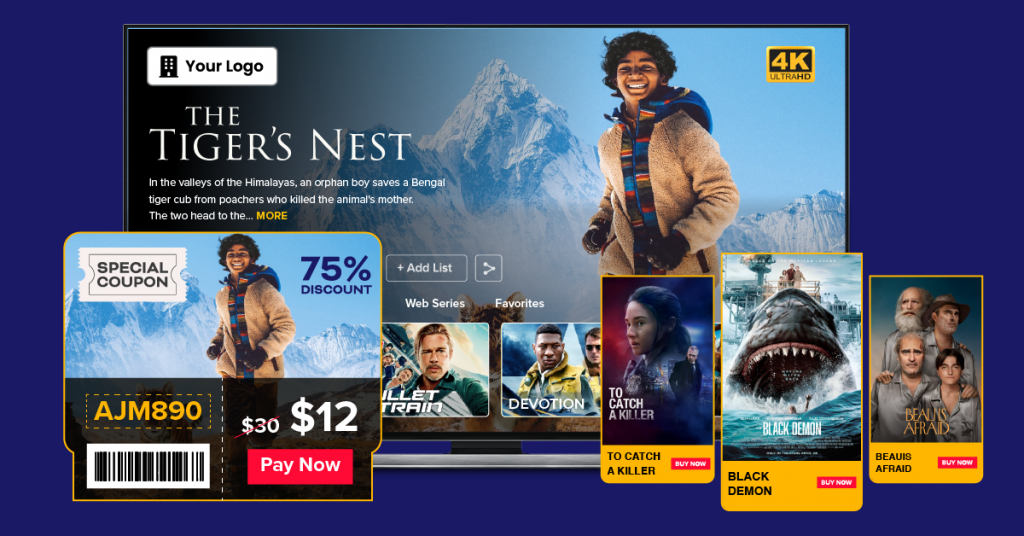
While exploring the best video monetization models, sponsored ads seemed like an interesting choice, because, unlike traditional ads, these sponsored ads are woven naturally into the video content.
This model is ideal for content owners who own content that resonates well with the brands. For example, a fitness channel advertently attracts health and wellness brands while gadget review channel attracts gadget manufacturers and vendors.
Some best practices of sponsored ads are maintaining transparency, prioritizing quality over quantity, and ensuring that the ads resonate with the audience’s preferences.
6. Coupons & Promotion
This is a practical solution for content owners. Collaborating with brands allows them to offer exclusive discounts and promotions to viewers.
This, in turn, helps build and nurture a long-term community. Moreover, the limited-time discounts and promotions create a sense of urgency among the viewers.
A key tip:
Content producers should partner with brands sharing similar values for genuine and relevant promotions, ensuring effectiveness in video monetization.
7. To sell merchandise & digital products
While exploring the best way to monetize video content, selling own merchandise and digital products came across as worthwhile, because it offers a chance to establish a direct relationship with the audience.
Besides revenue from content creation, this offers an additional revenue stream for content creators and broadcasters.
Moreover, when audiences purchase merchandise, they become word-of-mouth (WOM) ambassadors for your brand (as a whole!).
Some of the best practices in the video monetization strategy are following a competitive pricing strategy, and gathering authentic feedback for product enhancement.
8. Affiliate Marketing
If selling the merchandise makes you a retailer, affiliate marketing makes you a trusted product advisor. Unlike selling your merchandise, there is no required upfront cost while doing affiliate marketing campaigns. You can make money through commissions from brands who partner with your channel or content creation journey.
This method is ideal for content creators who specialize in tech reviews, gadget reviews, product tutorial videos, and so on.
Key Challenges in Video Monetization That Can Hinder Your Revenue
Now that we have covered what is video monetization and the top ways to make money with videos, it’s important to understand that the path to video monetization isn’t always fruitful; it does come with several challenges. Understanding how to navigate these challenges can help you become more resilient:
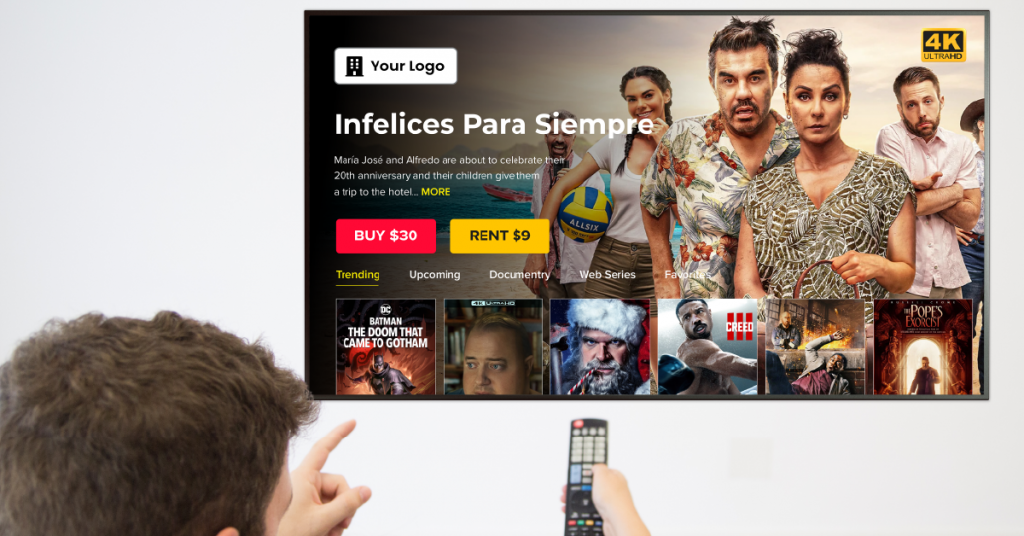
1. Content & Audience Challenges
The secret sauce of a successful video monetization strategy rests on a creator’s ability to produce engaging content. What engages one set of audiences may not appeal to another. Understanding and catering according to audience preferences may become complex as creators scale.
Our analysis of popular content creators revealed that over 70% of them struggle to follow a consistent release schedule, delaying content delivery and audience engagement rates by a considerable amount.
Adding to this complexity, audience thresholds create initial revenue barriers for content creators. For example, the YouTube Partner Program requires a minimum of 1,000 subscribers to activate ad revenue.
These challenges highlight that creators must spend substantial time and effort before seeing consistent returns through video content monetization.
2. Platform & Policy Challenges
Platform dependency hampers revenue possibilities, especially due to algorithm updates, policy changes, and so on. Creators who depend on a single platform may face revenue shortage, which in turn, slows down the content creation journey.
What one can do is leverage online video monetization platforms that ensure complete transparency. Take VPlayed, for example, which is an online video monetization platform, ensuring complete platform ownership for the content creators. Most importantly, creators get to retain 100% of their revenue, eliminating the need for revenue sharing.
Looking To Build Your Own Video Monetization Platform?
Start and Grow Your Video Streaming Service With 1000+ Features & 10+ Revenue Models.
Highly Customizable
Life Time Ownership
Own 100% of Your Revenue
Full-Branding Freedom
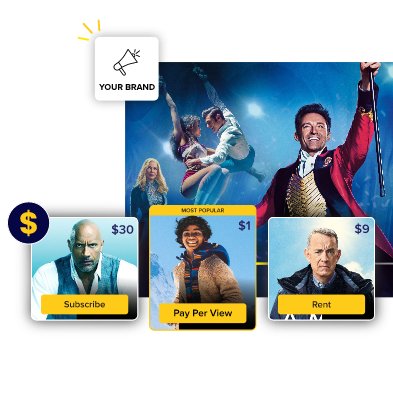
3. Technical & Economic Challenges
Creators often start with basic infrastructure. As their content starts gaining traction, the growing audience demands better technical infrastructure.
A basic CDN might struggle to complement the growing audience, whereas a global CDN (content delivery network) can handle an expanding audience base while ensuring rapid content delivery worldwide.
Moreover, standard video players might struggle with compatibility beyond specific browsers and devices. However, HTML5 video player will ensure cross-platform compatibility, ensuring seamless playback on any browser or device.
While multiple demands may pose a threatening challenge, timing your investment in such demands holds the key. Ensure that technical investments do not exceed the actual revenue potential of your video monetization models.
Conclusion
We’ve reached the final phase of the blog. We know there’s plenty of information to process, right from what is video monetization to top monetization methods, and key challenges video monetization faces in 2026.
Video monetization is extracting the full potential of video assets, but there is no perfect, works-for-all strategy. We hope, with this guide, you can identify a video monetization model that works for your video business.
A solid video monetization model, along with VPlayed, allows you to take complete control over the revenue. With support for marketing and customer management tool integrations, VPlayed helps you get started to monetize video effectively.
- Request Demo Book a Live, Personalized Demo
- Contact Sales Reach Out to Our OTT Experts
Frequently Asked Questions (FAQ):
1. What is Video Monetization?
Video monetization is the process of generating revenue through various video content monetization models such as subscriptions, advertisements, brand partnerships, or donations. Content creators use these video monetization models to build consistent income streams backed by an effective monetization strategy.
2. How Can I Monetize My Videos Online?
To monetize your videos online, you can leverage platforms such as YouTube, VPlayed, or social media channels. Start by producing high-quality content that appeals to your target audience. Next, fulfill the platform’s monetization criteria. Finally, activate monetization features and explore opportunities like ad revenue, sponsorships, merchandise sales, and more.
3. How to Choose the Best Video Monetization for Your Business?
When choosing a video monetization platform for your business, consider factors like your target audience, content type, revenue goals, and platform features. Conduct research on platforms such as VPlayed, Vimeo OTT, or Wistia, and assess their monetization capabilities, analytics, customization options, user-friendliness, and revenue-sharing models.
4. What Are the Types of Revenue Models Available in Video Monetization?
Video monetization offers various revenue models:
* Artising-based: Placing ads in videos to earn revenue based on impressions or clicks.
* Subscription-based: Viewers pay a recurring fee for premium or exclusive content.
* Transactional-based: Charging users for video downloads, rentals, or purchases.
* Sponsorship-based: Partnering with brands for product placements or endorsements.
* Crowdfunding-based: Relying on audience contributions to support ongoing video production.
5. What Are the Benefits of Using Video Monetization?
Video monetization offer benefits such as revenue generation, wider reach, detailed analytics, diverse monetization options, and valuable support and resources for content creators. They enable earning from content, reaching a broader audience, tracking performance, choosing suitable revenue models, and accessing guidance and tools to optimize video quality.
